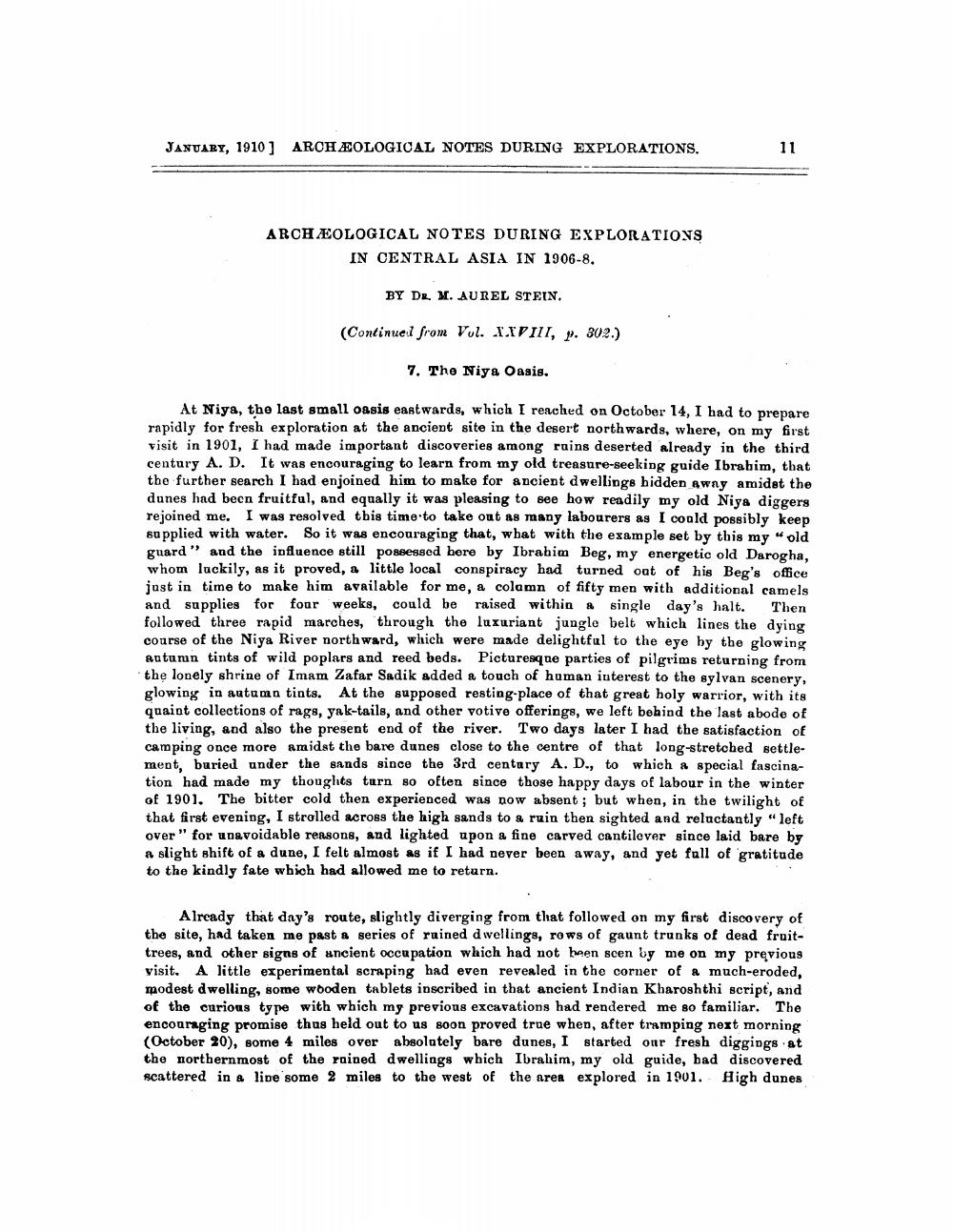________________
JANUARY, 1910] ARCHÆOLOGICAL NOTES DURING EXPLORATIONS.
11
ARCHÆOLOGICAL NOTES DURING EXPLORATIONS
IN CENTRAL ASIA IN 1906-8.
BY DL. M. AUREL STEIN.
(Continuel from Vul. LIVIII, p. 302.)
7. The Niya Oasis.
At Niya, the last small oasis eastwards, which I reached on October 14, I had to prepare rapidly for fresh exploration at the ancient site in the desert northwards, where, on my first visit in 1901, I had made important discoveries among rains deserted already in the third century A. D. It was encouraging to learn from my old treasure-seeking guide Ibrahim, that the further search I had enjoined him to make for ancient dwellings bidden Awny amidst the dunes had been fruitful, and equally it was pleasing to see how readily my old Niya diggers rejoined me. I was resolved this time to take out as many labourers as I could possibly keep supplied with water. So it was encouraging that, what with the example set by this my "old guard" and the influence still possessed here by Ibrahim Beg, my energetic old Darogha, whom luckily, as it proved, a little local conspiracy had turned out of his Beg's office just in time to make him available for me, a colamn of fifty men with additional camels and supplies for four weeks, could be raised within a single day's halt. Then followed three rapid marches, through the luxuriant jungle belt which lines the dying course of the Niga River northward, which were made delightful to the eye by the glowing autumn tints of wild poplars and reed beds. Picturesque parties of pilgrims returning from the lonely shrine of Imam Zafar Sadik added a touch of human interest to the sylvan scenery, glowing in autumn tints. At the supposed resting place of that great holy warrior, with its quaint collections of rage, yak-tails, and other votive offerings, we left behind the last abode of the living, and also the present end of the river. Two days later I had the satisfaction of camping once more amidst the bare dunes close to the centre of that long-stretched settlement, buried under the sands since the 3rd centary A. D., to which a special fascination had made my thoughts turn so often since those happy days of labour in the winter of 1901, The bitter cold then experienced was now absent ; but when, in the twilight of that first evening, I strolled across the high sands to a ruin then sighted and reluctantly " left over" for unavoidable reasons, and lighted upon a fine carved cantilever since laid bare by a slight shift of a dune, I felt almost as if I had never been away, and yet fall of gratitude to the kindly fate which had allowed me to return.
Already that day's route, slightly diverging from that followed on my first discovery of the site, had taken me past a series of ruined dwellings, rows of gaunt trunks of dead fruittrees, and other signs of ancient occupation which had not been seen by me on my previous visit. A little experimental scraping had even revealed in the corner of a much-eroded, modest dwelling, some wooden tablets inscribed in that ancient Indian Kharoshthi script, and of the curious type with which my previous excavations had rendered me so familiar. The encouraging promise thus held out to us soon proved true when, after tramping next morning (October 20), some 4 miles over absolutely bare dunes, I started our fresh diggings at the northernmost of the rained dwellings which Ibrahim, my old guide, bad discovered scattered in a line some 2 miles to the west of the area explored in 1901. High dunes




